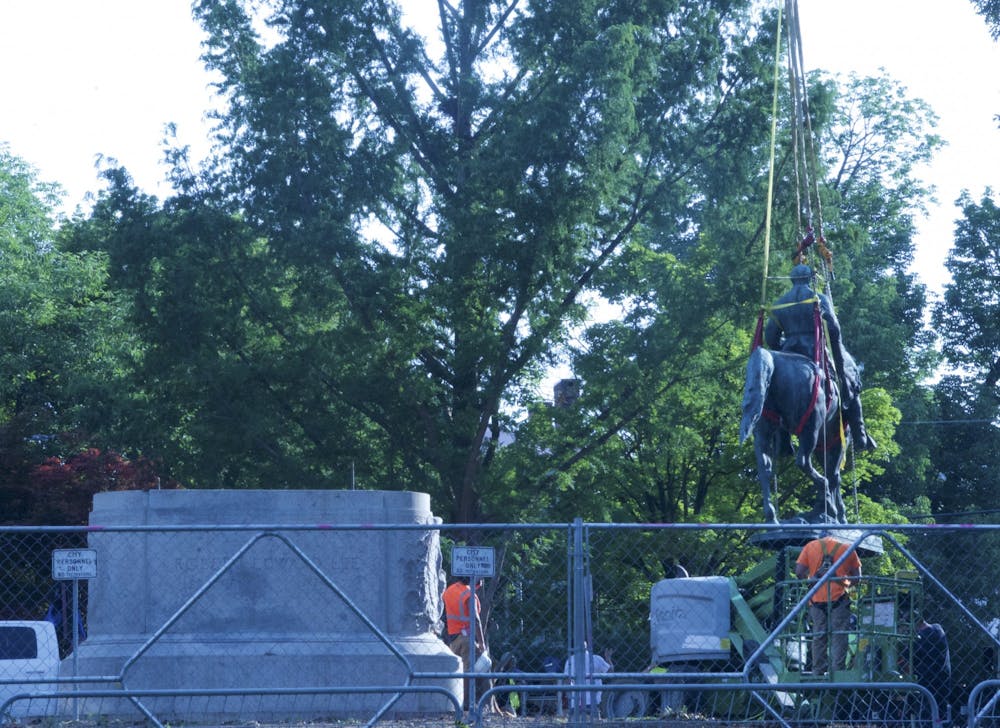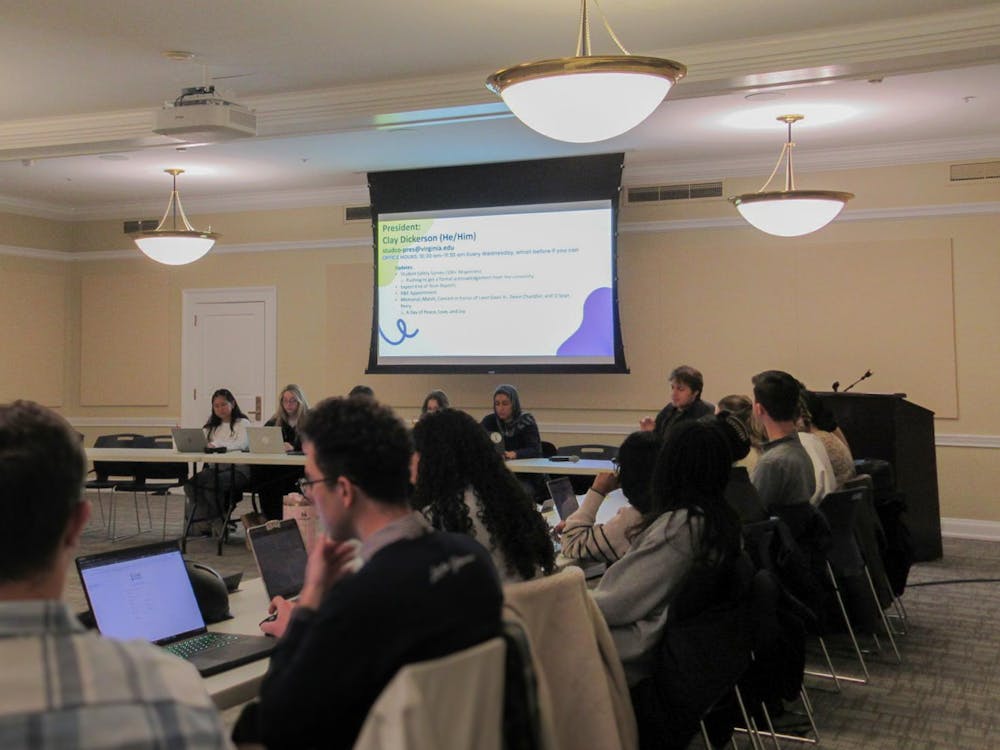In the early hours of Saturday morning, a group of about 100 community members and activists gathered to watch the statues of Robert E. Lee in Market Street Park and Thomas “Stonewall” Jackson in Court Street Park be removed, marking the end of nearly four years of litigation and activism. The statues will be placed in storage and their stone bases will be removed at a later date.
Rising third-year College student Zyahna Bryant, who first authored the petition to remove the Lee monument in 2016 as a high school freshman at Charlottesville High School, spoke to the crowd ahead of the statue’s removal.
“This is well overdue,” Bryant said. “The work of removing the statue is only the tip of the iceberg.”
Bryant said she hopes her success inspires and empowers other young people to take charge, adding that there is still plenty of work to be done in Charlottesville to address other issues like affordable housing, policing and the wealth gap. In an op-ed for Teen Vogue, Bryant urged readers to support and listen to Black women working to dismantle racism in their communities.
“Do not wait until we have passed or reached our breaking point to honor us or to give us our well-deserved flowers,” Bryant said. “Honor us while we are well. Honor us as we are doing the work that others choose not to do. Honor us in the rooms where we are not present.”
Charlottesville mayor Nikuyah Walker spoke after Bryant and thanked the many activists and community members who helped make the statues’ removal possible.
“It is my hope that we stop taking these steps in 100-year increments,” Walker said.
Walker also encouraged attendees to support other anti-racist efforts in Charlottesville, such as implementing the instruction of critical race theory, a subject of much discussion nationwide recently.
According to the Daily Progress, City Council appropriated $1 million in funding from the Capital Improvement Program Contingency Fund Wednesday for the removal, storage and relocation of the statues. A 2017 estimate of the price of the statues’ removal was $330,000 to $350,000 per statute — a number which City Manager Chip Boyles said is still a close estimate of what it would cost in 2021.
As the crew lifted the Lee statue from its pedestal and carried it away from Market Street Park Saturday morning, the crowd cheered and relocated to Court Street Park, where the crew then prepared the Jackson statue for removal. Standing at the barrier constructed outside Court Street Park, Assoc. Religious Studies Prof. and activist Jalane Schmidt said she felt relieved watching both statues be taken down. Schmidt developed the Marked by These Monuments Tour to educate the public about the history of Charlottesville’s monuments and was active in organizing counter-protests against the white supremacist rallies held in 2017.
“A lot of people have been working for a lot of years at great personal risk, at great cost,” Schmidt said. “It’s a really great thing to see your work come to fruition.”
The city has started to solicit expressions of interest for removal, relocation and transfer of the statues to any museum, historical society, government or battlefield. According to a press release, 10 responses have been received so far, four of which are in-state and six of which are out-of-state.
Commissioned in 1917 and 1919, respectively, the Robert E. Lee statue was first erected in 1924 while the Stonewall Jackson statue was erected in 1921. The construction of the statues was funded by Paul Goodloe McIntire, the namesake of the University’s McIntire School of Commerce, McIntire Amphitheatre and McIntire Department of Art. McIntire also bought Lee Park — which was renamed to Market Street Park in 2018 — and Jackson Park — which was renamed Court Square Park — to house the statues.
After Bryant’s 2016 petition quickly gained traction, the Charlottesville City Council created the Blue Ribbon Commission on Race, Memorials and Public Spaces to seek public comment on the statues and make a recommendation on their futures. The group’s final report, released in December 2016, suggested removal and relocation or contextualization of the statues.
City Council voted to remove the Lee statue and rename its park two months later and was swiftly met with a lawsuit from various individuals and organizations — including the Monument Fund and the Virginia Division of Sons of Confederate Veterans — to prevent changes being made to either park.
The plaintiffs argued that state code § 15.2-1812 — passed by the General Assembly in 1997 — prevented city council from removing either statue. The state code bans localities from removing, interfering with and contextualizing or covering monuments without following appropriate guidelines. However, the City argued that because the law was passed in 1997, it could not be retroactively applied to statues erected more than 50 years before.
Controversy over the statues soon drew national attention, culminating in the events of Aug. 11 and 12, 2017 and the violent “Unite the Right'' rally.
The night before the rally, several hundred white supremacists marched on the Lawn brandishing torches and chanting “White Lives Matter” and “Jews will not replace us.” They were met by a group of counter-protestors at the Thomas Jefferson statue on the North side of the Rotunda, where a fight broke out until police were able to separate the two groups.
The following day, the “Unite the Right” rally turned deadly, as rioters killed three people, including activist and Charlottesville resident Heather Heyer, and injured 19 others.
Following the rally, City Council approved a motion to shroud the statues in black to mourn the victims of the violence, but a judge later ordered the city to remove the tarps.
In September 2017, City Council voted to remove the Jackson statue, pending the result of the ongoing lawsuit.
Almost three years after the rally, Gov. Ralph Northam signed a law allowing individual localities to remove, relocate or contextualize Confederate statues and monuments within their communities. The legislation went into effect in July 2020.
Delegate Sally Hudson, D-Charlottesville, cosponsored the legislation. At the statues’ removal Saturday morning, Hudson described the moment as “a long time coming.”
“I’m just excited to see the community reclaim this space,” Hudson said. “It’s been decades since people could feel welcome.”
The lawsuit concerning the Lee and Jackson statues was finally resolved in April 2021 when the Supreme Court of Virginia ruled in favor of the city, holding that the ban on interfering with the statues could not be applied to the monuments constructed before it was passed.
“The statues were erected long before there was a statute which both authorized a city’s erection of a war memorial or monument and regulated the disturbance of or interference with that war memorial or monument,” the Supreme Court judgement reads. “In other words, Code § 15.2-1812 did not provide the authority for the city to erect the statues, and it does not prohibit the city from disturbing or interfering with them.”
This decision strengthened calls for the city to remove the statues, with former members of the Blue Ribbon Commission calling on city council to immediately shroud the statues until their removal. On June 8, city council unanimously voted to remove the statues after hosting a public hearing, with the requirement that they wait 30 days from the meeting.
When the city announced that the statues would be removed Saturday, Bryant noted that the removal of the statues should not be the end of the city’s work to remove symbols of the Confederacy.
“This is a crucial first step in the right direction to tell a more historically accurate and complete story of this place and the people who call this place home,” Bryant said.
At noon, City Council held an emergency meeting and unanimously voted to also remove the Meriwether Lewis, Clark and Sacagawea statue that afternoon, following the successful removal of the Confederate monuments. The Confederate statues were removed ahead of schedule, according to a media update from City Spokesperson Brian Wheeler, allowing for the removal of the third statue, which will be relocated to City-owned or co-owned storage space.
The City passed a resolution in November 2019 to remove the depiction of Sacagawea cowering behind Meriwether Lewis and William Clark at West Main Street’s major intersection. The session included a presentation from City staff, statements from the Shoshone representatives and a two part discussion regarding the statue in collaboration with members of the Shoshone-Bannock tribe and Monacan Indian Nation.







